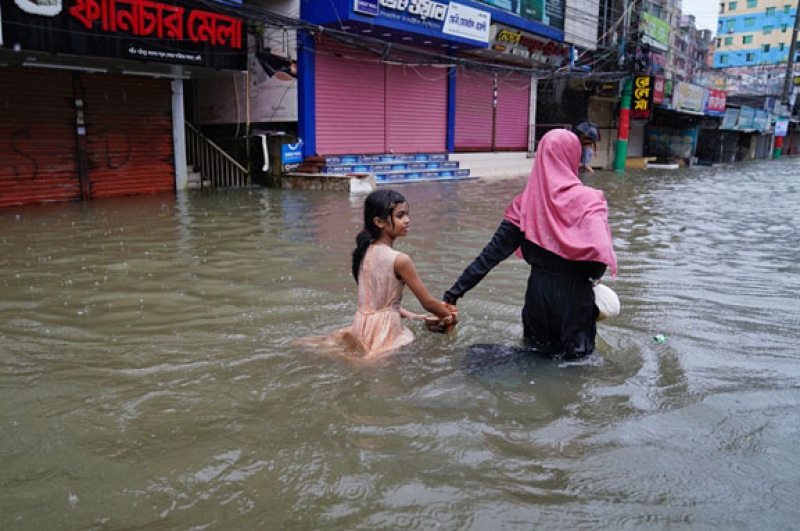- Trump considering military options on Greenland; Europe rejects |
- Fertiliser crunch threatens Kushtia’s onion boom despite high prices |
- Security Council Divided on United States' Venezuela Action |
- Over 1.53m voters register for postal balloting: Shafiqul Alam |
Climate Change Is Reshaping Asia-Pacific Economies

A mother and daughter wading through the flood waters in Feni, Bangladesh in 2024. Catastrophic floods disrupted employment, trade and economy. Policymakers should stand ready to implement policies for speedy recovery.
In the past year, Asia and the Pacific have faced intensifying climate pressures — from extreme heat in Bangladesh and India to devastating floods in northern Thailand and rising food insecurity across the Pacific.
But these are just the most visible signs. Beneath the surface, increasing temperatures, shifting rainfall patterns, and rising sea levels are quietly eroding fiscal space, distorting prices of goods and services, and weakening long-term economic resilience. Climate risks — both sudden and gradual — are reshaping the region’s macroeconomic landscape.
The latest ESCAP Economic and Social Survey of Asia and the Pacific explores how this evolving threat is affecting jobs, inflation, public finance, and economic stability. To better understand countries’ readiness to confront these risks, ESCAP has developed a new assessment framework that evaluates the intersection of climate exposure and macroeconomic coping capacity.
The framework focuses on two core dimensions: exposure, measured through potential output losses, agricultural risk, carbon intensity, and climate-driven inflation; and macroeconomic coping capacity, assessed through fiscal space, financial sector health, and institutional effectiveness.
When plotted on a two-axis matrix, countries fall into four quadrants depending on their exposure and coping ability. This matrix serves as a comparative tool to guide targeted policymaking.
Countries in the high exposure–low capacity quadrant face the most pressing risks. For example, Afghanistan, Cambodia, and Nepal fall in this category due to both geographic and structural vulnerabilities — including recurrent climate events, limited fiscal buffers, and weaker institutions.
The high exposure–high capacity quadrant includes countries such as Kazakhstan, Mongolia, and Viet Nam. While each faces different forms of climate stress, they share stronger governance and macroeconomic fundamentals, enabling more effective responses.
China, Malaysia, and Thailand fall into the low exposure–high capacity quadrant. These economies currently enjoy lower climate exposure and resilient financial systems. However, they still need significant adaptation investment to prevent future vulnerability — especially given regional interdependence and evolving risks.
Lastly, the low exposure–low capacity quadrant includes countries such as Lao PDR, Papua New Guinea, and the Solomon Islands. While they face fewer direct climate threats today, weak institutional and fiscal capacity leaves them vulnerable to even moderate shocks, which could have severe economic consequences.
Overall, the quadrant framework underscores the need for differentiated policy approaches. Countries with high exposure and low capacity should focus on expanding fiscal space, enhancing financial sector resilience — including through climate-aligned regulations and risk tools — and strengthening institutional effectiveness.
In contrast, countries with low exposure and high capacity are well-positioned to invest in adaptation innovation and support regional peers.
Climate change is already disrupting employment, trade, investment, and public finance across the region. It is no longer an external shock but a defining macroeconomic challenge.
Governments must respond with sustained, systemic reforms. Macroeconomic planning in Asia and the Pacific must prioritise resilience — not only to manage immediate shocks but to navigate a climate-shaped economic future.
Shuvojit Banerjee is Economic Affairs Officer, ESCAP.

